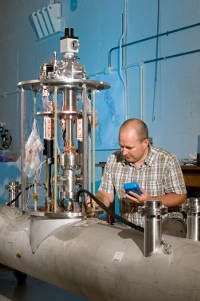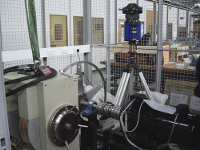 |
 |
|||||||||||||
|
|||||||||||||
|
|||||||||||||
|
The team developing the ILC's positron source have every reason to be positive. Recent tests have shown both that the four-meter helical undulator prototype – a device that will produce an intense beam of polarised gamma rays – works in its cryomodule, and that the target that will produce the positrons themselves can reach its design rotation speed of 2000 revolutions per minute. After successful tests with much smaller prototypes (see archive) the large undulator prototype, complete with cryomodule, exceeded its design field of 0.86T in a test at Rutherford Appleton Lab near Oxford in the UK. The team is especially pleased about this result because they had previously found a design flaw in the cryomodule that had resulted in a helium leak into the vacuum pipe. The module underwent a modification and now functions better than expected. The superconducting magnet inside the cryomodule directs the electrons flying through it onto a wavy – undulating – path, forcing them to emit photons with energies that depend on the length of the undulations. So far so good – this has happened routinely in light sources around the world for years. It's the combination of superconductivity, helicity and its use in high-energy physics that makes this undulator special. The magnet consists of two interlocking coiled windings of superconducting ribbon, like two massive corkscrews, that send the electrons onto their controlled spiralling flight path. The electromagnetic fields emitted by the electrons overlap and "interfere" and, in the case of the full-length undulator planned for the ILC, will cause each electron to emit hundreds of photons all going in the same direction, giving a beam only one millimetre in radius even after the photons have travelled for hundreds of metres. At the same time, the spiralling path of the electrons will give the photons a characteristic spin, which is the key to later obtaining a polarised positron beam. "Apart from the early leak the alignment of the two undulators was also quite a challenge," says James Rochford from Rutherford Appleton Lab,"and we are delighted by the cryomodule performance." A modification to the alignment fixture has already been manufactured and this will allow for a much easier and more accurate adjustment of the undulator straightness. In the end, the ILC's positron factory will feature some fifty of these undulator cryomodules to make one giant undulator. In the ILC design, the polarised photons coming from the spiralling electrons next hit a titanium alloy target to produce the positrons (and more electrons and photons, but those aren't needed and are thus discarded). This target is about one metre in diameter and looks like a metal wagonwheel complete with spokes and a rim. It's the rim that produces the secondary particles as the photons shower through it, and because this is a rather energetic "hot" shower the wheel needs to be cooled and it needs to rotate as fast as possible to make sure that no region of the surface gets more exposure than any other. Without being rotated, the wheel would not survive very long; already the baseline design foresees precautionary changes of the target wheel every year or so. This wheel has recently shown that it can rev up to 2000 turns per minute, the design value, and the team has started taking data. Eddy currents – stray currents induced by neighbouring magnets designed to "capture" positrons that can hinder the wheel's motion are a main focus of these first tests, as well as the mechanical stability of the wheel itself. "It is already good to have a stably rotating target, now we are looking forward to analysing the test data with the magnetic field applied to see how it compares with our simulations," says Ian Bailey from the Cockcroft Institute. -- Barbara Warmbein |
|||||||||||||
| © International Linear Collider |

